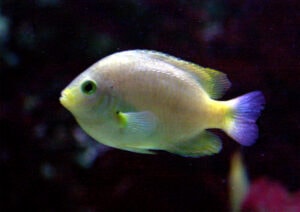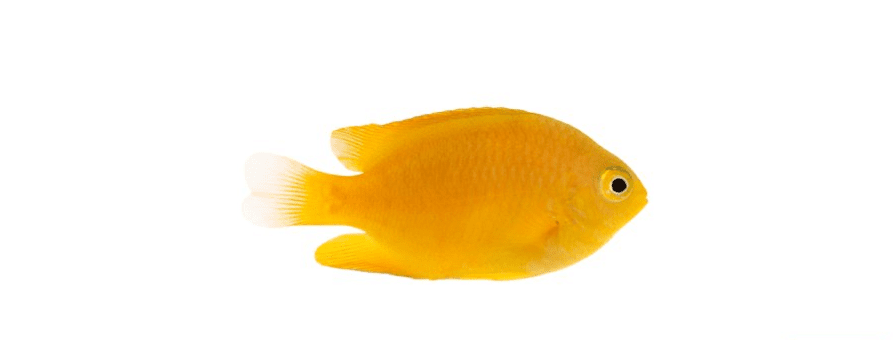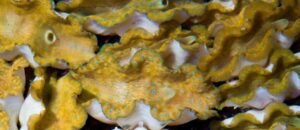Damselfish (Family Pomacentridae) have always been among the most popular saltwater aquarium fishes. As they are small, hardy and abundant in the wild, they are generally relatively inexpensive. Thus, they are traditionally recommended by stores as an ideal ‘starter fish.’ Indeed, before advancements in fishless cycling, they were commonly used to help cycle new systems. The problem with all this is that some damselfish (being highly territorial) can become extremely aggressive, particularly when added before their tankmates. Some damsel species are so brutal that they can injure or kill even larger fish.
Similar to clownfish, most damselfish species are easily bred and reared in captivity. Yet, unfortunately, because of their typically low import price, hobbyists have in the past been reluctant to purchase farmed stock, even at a very slightly higher cost. So it’s really awesome that ORA has put several highly desirable damselfish species into commercial production, and that today’s fishkeepers have been eager to purchase them. The reasons for the turnaround is pretty simple; even in the case of a hardy family like the damsels, farmed stock is far superior. For example, they are more socialized to aquarium life and are therefore a bit more accepting of other fish in ‘their’ territory. Also, like any cultured species, these damsels present a far smaller threat of introducing a disease to their new tank.
While there are quite a few damselfish species, ORA has thus far focused on the most colorful and peaceful species. Perhaps their most impressive offering so far has been the lemon damsel (Pomacentrus moluccensis).
Lemon damsel natural history
 The lemon damsel (also known as the Golden Damselfish, Molucca Damsel or Molucca Demoiselle) occurs in several locales across the Western Pacific Ocean and Eastern Indian Ocean including the Andaman Sea, Fiji, Tonga, Ryukyu Islands, Lord Howe Island and other spots in between. It is most commonly encountered in clear lagoons and seaward reefs where it forms small aggregations near branching corals (especially Pocillopora damicornis). It is targeted by predators such as groupers and large dottybacks. It is an omnivore that feeds primarily on benthic algae and planktonic crustaceans such as copepods. It is diurnal, being active mainly during the daylight hours.
The lemon damsel (also known as the Golden Damselfish, Molucca Damsel or Molucca Demoiselle) occurs in several locales across the Western Pacific Ocean and Eastern Indian Ocean including the Andaman Sea, Fiji, Tonga, Ryukyu Islands, Lord Howe Island and other spots in between. It is most commonly encountered in clear lagoons and seaward reefs where it forms small aggregations near branching corals (especially Pocillopora damicornis). It is targeted by predators such as groupers and large dottybacks. It is an omnivore that feeds primarily on benthic algae and planktonic crustaceans such as copepods. It is diurnal, being active mainly during the daylight hours.
Part of its territoriality comes from its ‘family life.’ It exhibits distinct pairing during breeding. Eggs are demersal (laid directly on and attached to some hard surface). The male ferociously guards and even aerates the eggs. Studies of wild populations have found that individual lemon damsels rarely wander more than a couple meters from their little home territory.
The lemon damsel obviously gets its name from its bright yellow coloration. In some cases, the yellow is cast over a snowy white base color (especially in mature individuals). Some might get a few orange ‘freckles’ on the face, mainly just behind the eyes. Except for specimens from the Philippines, there is typically a small orange spot at the base of the pectoral fin. Blue lines run across its head and fins of some individuals. Adults reach a length of around three inches.
Aquarium care
The lemon damsel is (at least for a damsel) fairly peaceful in the reef aquarium. In fact, if you start with two young individuals, you likely will end up with a pair. ORA states that they’ve successfully kept their farmed specimens with other damsels including yellowtail blue damsels and sapphire damsels.
Like most of its damsel cousins, it is extremely tolerant of not-so-great water quality and other environmental stress. Because of its small size, it is a great candidate for a smaller tank. A 30-gallon or larger aquarium is ideal, however. To that point, it can be kept as a group in larger tanks of 75 gallons or more.
All in all, this species is perfect for the beginner hobbyist, or anyone that appreciates tough, unfussy, trouble-free fish. While success with this super-tough species is virtually guaranteed for most keepers, you’ll get the longest lives, best coloration, etc. out of them by maintaining good water quality, providing lots of rocky hiding places and of course providing them with a varied diet of high quality foods.
Conclusion
It’s a wonderful thing that damsels (which have been a staple of the marine aquarium trade for generations) are finally widely available as captive bred. To be fair, even the cultured specimens are inexpensive. And they just make for better pets overall, being less prone to aggressive behavior, disease, etc. Plus they are more sustainably produced! There’s no denying that captive bred damsels are a wise choice, and ORA makes this choice easier with seriously lovable species such as the boldly colored lemon damsel.
While we can very strongly recommend this species (these farmed specimens from ORA particularly, of course) to newbie fish keepers, it probably true that any advanced hobbyist would love these beautiful and ceaselessly active fish just as much!






Charles Rafferty says
Thank you for detailed info . Im interested in anything you put out you are the university of marine science i am interested in your captive bred gold nugget maroon clowns for new 45 gal cube type tank out of desperation i am filling tank with sea water sold on line